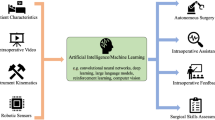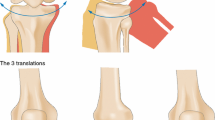Abstract
Purpose
The aim of this work is to determine face validity and construct validity of a new virtual-reality-based simulator for diagnostic and therapeutic knee arthroscopy.
Methods
The study tests a novel arthroscopic simulator based on passive haptics. Sixty-eight participants were grouped into novices, intermediates, and experts. All participants completed two exercises. In order to establish face validity, all participants filled out a questionnaire concerning different aspects of simulator realism, training capacity, and different statements using a seven-point Likert scale (range 1–7). Construct validity was tested by comparing various simulator metric values between novices and experts.
Results
Face validity could be established: overall realism was rated with a mean value of 5.5 points. Global training capacity scored a mean value of 5.9. Participants considered the simulator as useful for procedural training of diagnostic and therapeutic arthroscopy. In the foreign body removal exercise, experts were overall significantly faster in the whole procedure (6 min 24 s vs. 8 min 24 s, p < 0.001), took less time to complete the diagnostic tour (2 min 49 s vs. 3 min 32 s, p = 0.027), and had a shorter camera path length (186 vs. 246 cm, p = 0.006).
Conclusion
The simulator achieved high scores in terms of realism. It was regarded as a useful training tool, which is also capable of differentiating between varying levels of arthroscopic experience. Nevertheless, further improvements of the simulator especially in the field of therapeutic arthroscopy are desirable. In general, the findings support that virtual-reality-based simulation using passive haptics has the potential to complement conventional training of knee arthroscopy skills.
Level of evidence
II.



Similar content being viewed by others
References
Aggarwal R, Tully A, Grantcharov T, Larsen CR, Miskry T, Farthing A, Darzi A (2006) Virtual reality simulation training can improve technical skills during laparoscopic salpingectomy for ectopic pregnancy. BJOG Int J Obstet Gynaecol 113:1382–1387
Bajka M, Tuchschmid S, Fink D, Székely G, Harders M (2009) Establishing construct validity of a virtual-reality training simulator for hysteroscopy via a multimetric scoring system. Surg Endosc 24:79–88
Bajka M, Tuchschmid S, Streich M, Fink D, Székely G, Harders M (2008) Evaluation of a new virtual-reality training simulator for hysteroscopy. Surg Endosc 23:2026–2033
Basdogan C, Sedef M, Harders M, Wesarg S (2007) VR-based simulators for training in minimally invasive surgery. IEEE Comput Graph Appl 27:54–66
Bayona S, Fernández-Arroyo JM, Martín I, Bayona P (2008) Assessment study of insight ARTHRO VR® arthroscopy virtual training simulator: face, content, and construct validities. J Robot Surg 2:151–158
Cannon WD, Eckhoff DG, Garrett WE Jr, Hunter RE, Sweeney HJ (2006) Report of a group developing a virtual reality simulator for arthroscopic surgery of the knee joint. Clin Orthop Relat Res 442:21–29
Carter FJ, Schijven MP, Aggarwal R, Grantcharov T, Francis NK, Hanna GB, Jakimowicz JJ (2006) Consensus guidelines for validation of virtual reality surgical simulators. Simul Healthc 1:171–179
Farnworth LR, Lemay DE, Wooldridge T, Mabrey JD, Blaschak MJ, DeCoster TA, Wascher DC, Schenck RC (2001) A comparison of operative times in arthroscopic ACL reconstruction between orthopaedic faculty and residents: the financial impact of orthopaedic surgical training in the operating room. Iowa Orthop J 21:31–35
Gallagher AG, Ritter EM, Satava RM (2003) Fundamental principles of validation, and reliability: rigorous science for the assessment of surgical education and training. Surg Endosc 17:1525–1529
Gomoll AH, Pappas G, Forsythe B, Warner JJP (2008) Individual skill progression on a virtual reality simulator for shoulder arthroscopy: a 3-year follow-up study. Am J Sports Med 36:1139–1142
Haque S, Srinivasan S (2006) A meta-analysis of the training effectiveness of virtual reality surgical simulators. IEEE Trans Inf Technol Biomed 10:51–58
Howells NR, Gill HS, Carr AJ, Price AJ, Rees JL (2008) Transferring simulated arthroscopic skills to the operating theatre: a randomised blinded study. J Bone Jt Surg Br 90:494–499
Khalifa YM, Bogorad D, Gibson V, Peifer J, Nussbaum J (2006) Virtual reality in ophthalmology training. Surv Ophthalmol 51:259–273
Koch F, Koss MJ, Singh P, Naser H (2009) Virtual reality in ophthalmology. Klin Monbl Augenheilkd 226:672–676
Larsen C, Grantcharov T, Schouenborg L, Ottosen C, Soerensen J, Ottesen B (2008) Objective assessment of surgical competence in gynaecological laparoscopy: development and validation of a procedure-specific rating scale. BJOG Int J Obstet Gynaecol 115:908–916
Larsen CR, Soerensen JL, Grantcharov TP, Dalsgaard T, Schouenborg L, Ottosen C, Schroeder TV, Ottesen BS (2009) Effect of virtual reality training on laparoscopic surgery: randomised controlled trial. BMJ 338:b1802
Mabrey JD, Reinig KD, Cannon WD (2010) Virtual reality in orthopaedics: is it a reality? Clin Orthop Relat Res 468:2586–2591
McCarthy AD, Hollands RJ (1998) A commercially viable virtual reality knee arthroscopy training system. Stud Health Technol Inform 50:302–308
Meyer RD, Tamarapalli JR, Lemons JE (1993) Arthroscopy training using a “black box” technique. Arthroscopy 9(3):338–340
Modi CS, Morris G, Mukherjee R (2010) Computer-simulation training for knee and shoulder arthroscopic surgery. Arthroscopy 26(6):832–840
Moody L, Waterworth A, Arthur JG, McCarthy AD (2009) Beyond the visuals: tactile augmentation and sensory enhancement in an arthroscopy simulator. Virtual Real 13(1):59–68
Moody L, Waterworth A, McCarthy AD, Harley PJ (2008) The feasibility of a mixed reality surgical training environment. Virtual Real 12(2):77–86
Moorthy K, Munz Y, Sarker SK, Darzi A (2003) Objective assessment of technical skills in surgery. BMJ 327:1032–1037
Müller W, Bockholt U, Lahmer A, Voss G, Börner M (2000) VRATS—virtual reality arthroscopy training simulator. Radiologe 40:290–294
O’Neill PJ, Cosgarea AJ, Freedman JA, Queale WS, McFarland EG (2002) Arthroscopic proficiency: a survey of orthopaedic sports medicine fellowship directors and orthopaedic surgery department chairs. Arthroscopy 18:795–800
Panel P, Bajka M, Tohic A, Ghoneimi AE, Chis C, Cotin S (2012) Hysteroscopic placement of tubal sterilization implants: virtual reality simulator training. Surg Endosc 26(7):1986–1996
Pedowitz RA, Esch J, Snyder S (2002) Evaluation of a virtual reality simulator for arthroscopy skills development. J Arthrosc Rel Surg 18:e29
Schijven M, Jakimowicz J (2003) Construct validity: experts and novices performing on the Xitact LS500 laparoscopy simulator. Surg Endosc 17:803–810
Schijven MP, Jakimowicz J (2004) The learning curve on the Xitact LS 500 laparoscopy simulator: profiles of performance. Surg Endosc 18:121–127
Spillmann J, Tuchschmid S, Harders M (2013) Adaptive space warping to enhance passive haptics in an arthroscopy surgical simulator. IEEE Trans Vis Comput Graph 19:626–633
Srivastava S, Youngblood PL, Rawn C, Hariri S, Heinrichs WL, Ladd AL (2004) Initial evaluation of a shoulder arthroscopy simulator: establishing construct validity. J Shoulder Elbow Surg 13:196–205
Sutherland LM, Middleton PF, Anthony A, Hamdorf J, Cregan P, Scott D, Maddern GJ (2006) Surgical Simulation. Ann Surg 243:291–300
Tuijthof GJM, van Sterkenburg MN, Sierevelt IN, van Oldenrijk J, Van Dijk CN, Kerkhoffs GMMJ (2010) First validation of the PASSPORT training environment for arthroscopic skills. Knee Surg Sports Traumatol Arthrosc 18:218–224
Tuijthof GJM, Visser P, Sierevelt IN, Dijk CN, Kerkhoffs GMMJ (2011) Does perception of usefulness of arthroscopic simulators differ with levels of experience? Clin Orthop Relat Res 469:1701–1708
Woodrum DT, Andreatta PB, Yellamanchilli RK, Feryus L, Gauger PG, Minter RM (2006) Construct validity of the LapSim laparoscopic surgical simulator. Am J Surg 191:28–32
Ziegler R, Fischer G, Müller W, Göbel M (1995) Virtual reality arthroscopy training simulator. Comput Biol Med 25:193–203
Author information
Authors and Affiliations
Corresponding author
Additional information
Sandro F. Fucentese and Stefan Rahm have contributed equally to this work.
Rights and permissions
About this article
Cite this article
Fucentese, S.F., Rahm, S., Wieser, K. et al. Evaluation of a virtual-reality-based simulator using passive haptic feedback for knee arthroscopy. Knee Surg Sports Traumatol Arthrosc 23, 1077–1085 (2015). https://doi.org/10.1007/s00167-014-2888-6
Received:
Accepted:
Published:
Issue Date:
DOI: https://doi.org/10.1007/s00167-014-2888-6




